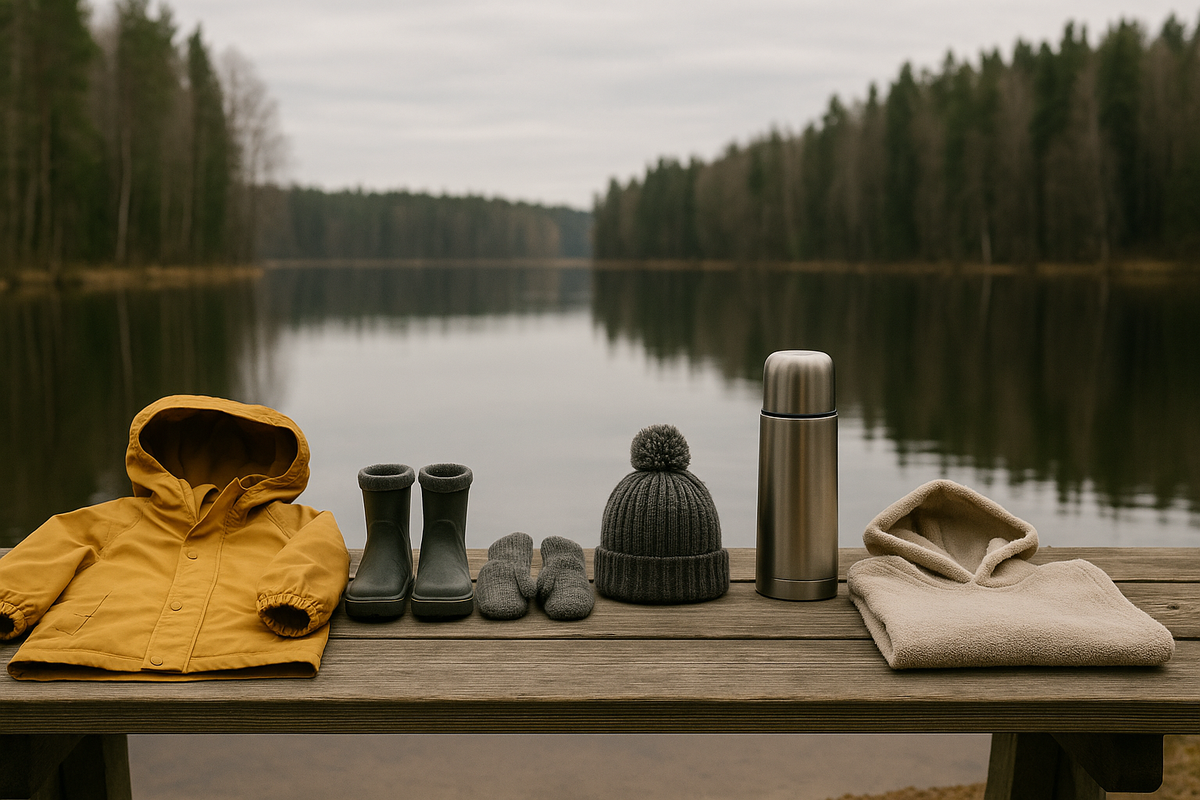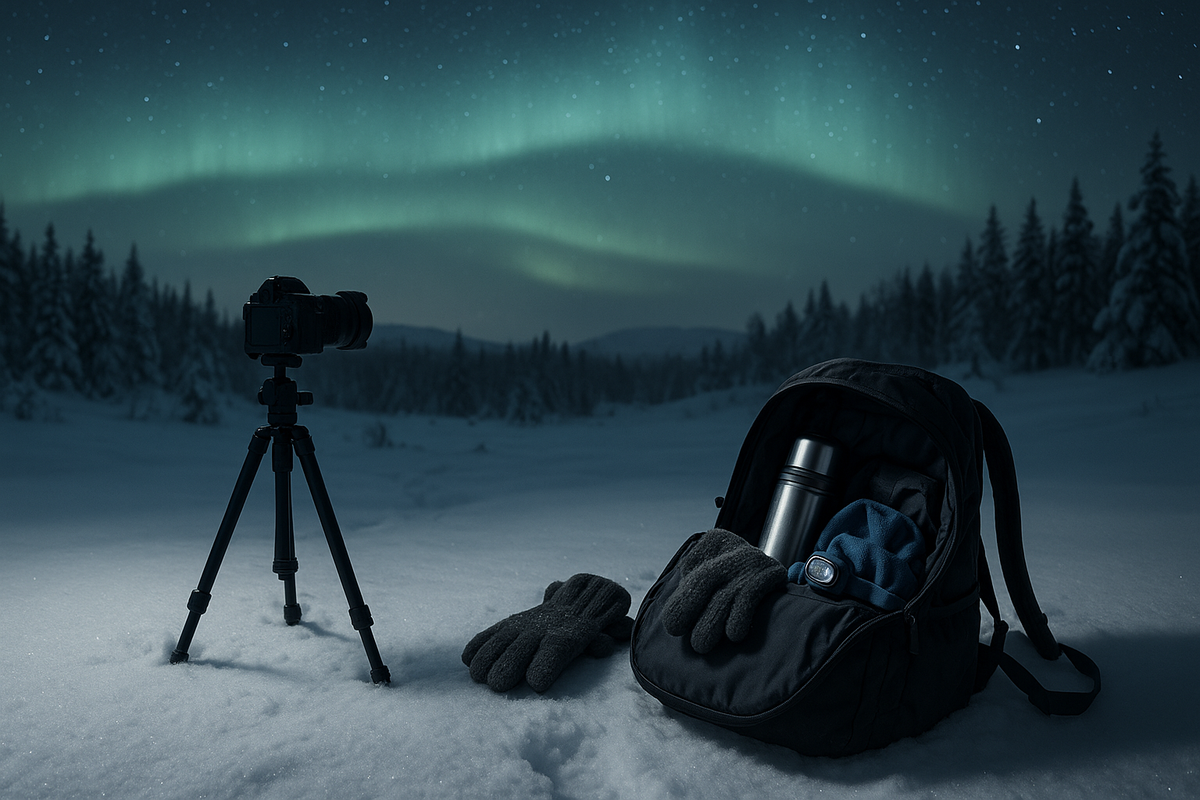🌦️ One bag for all seasons: a smart kit for Finland
Imagine: you're still at home, looking at the forecast, leafing through maps and articles about the weather and seasons in Finland, and the same thought keeps running through your head: "So what should I actually pack in my suitcase?"
We're not going to promise you a "perfect summer without rain" or a "winter without ice." Instead, we'll put together a set of items that will withstand a warm evening on the islands, wet snow in the city, and a walk in Lapland — all in one bag.

Principles that save space and nerves
Before you rush to your wardrobe, let's agree on three rules. If you keep them in mind, your suitcase will practically pack itself.
- Layers are more important than a cool jacket.
Instead of one "very warm" item, wear three sensible layers: a base layer (wick away moisture), a mid-layer (retain heat), and an outer layer (block wind and rain). This logic can be easily adapted for both summer and winter. - Don't just look at the temperature, but also at how it feels.
At +18 °C and a wind speed of 6 m/s near the water, you may feel cooler than at +10 °C with no wind in the forest. Finnish weather likes to play tricks like this. - Plan your day with a margin.
Morning — for activities (calm weather, light), rain front — for museums and cafes, second "window" in the evening — back to the embankment or trail. Your belongings should allow you to change your plans, not ruin them.
Common mistakes when packing your first suitcase
So that you don't make the same mistakes as half of all tourists:
● they take one heavy down jacket and suffer in transport — it's hot, in the wind — it's cold;
● they wear new shoes that are too big — and rub their feet on the first day;
● pack a ton of cotton — it takes a long time to dry and cools quickly;
● ignore black ice and wet granite — and are afraid to simply walk around the city;
● rely solely on an umbrella, which lasts exactly three minutes in the wind by the sea.
This article is about the opposite approach: fewer things, more control over your feelings.
Basic capsule by season (one glance and everything is clear)
This table is your visual "cheat sheet". Next, we simply substitute specific scenarios for these basic patterns: sea, lakes, cities, Lapland by season.
Universal checklist: what should almost always be in your suitcase
Universal packing checklist for Finland
- 2–3 moisture-wicking base layers (T-shirts or long-sleeves)
- 1–2 warm mid-layers (fleece or wool)
- 1 waterproof & windproof shell jacket (10–20K)
- 1 pair of grippy shoes (trainers or light hiking boots) Optional: winter boots + microspikes for icy season Buff, thin beanie, light gloves or liners
- Sunglasses and SPF for water/snow glare Sleep mask for bright nights
- PFD (life jacket) for any water activities
- Power bank + ziplock or dry bag for electronics
You can keep this list open while you pack — it quickly becomes clear what's missing.
The city, the sea, the lakes, Lapland: how the capsule performs
Cities by the sea (Helsinki, Espoo, Porvoo).
The main enemies are wet granite and wind on the embankments. Shoes with treads, a hood and a thin fleece — and evening walks are no longer a lottery. Even at +15 °C, it's easy to feel cold by the water without a windbreaker.
The Baltic Sea and islands.
Here, it turns out that an umbrella is not king, but a membrane is. Gusts of wind, splashes, slippery piers — that's why you need not only trainers with good grip, but also non-slip sandals if you plan to go SUP or kayaking.
Lake region.
The water in the lakes warms up, but the morning fog and wet grass quickly remind you of layers and gaiters. A simple set of clothes will come in handy here: a light membrane, spare socks, a buff in your pocket.
Lapland.
In winter, there is frost and short daylight hours, and in summer, there are long twilights and mosquitoes. But essentially, it's the same: thermal underwear, a mid-layer, a good outer layer, warm shoes, and face protection. It's just that in Lapland, you get to test how well you've put together your kit.
Footwear and traction: something that is often underestimated
● In summer, trainers with grippy soles and non-slip sandals are enough for piers and islands.
● In autumn and spring, lightweight trekking boots + gaiters come in very handy.
● In winter and in the off-season, a city with slopes and black ice can only be explored with microspikes.
Roots, stones and wooden walkways become slippery after rain. Here, short steps, walking sticks and a calm pace of "I came to look, not to run" help.
Accessories that make the weather bearable (and even pleasant)
● Buff: covers the neck, ears, part of the face — and easily fits in a pocket.
● A thin hat: even in summer, it can come in handy in the evening by the water.
● Sunglasses + SPF: water and snow glare, and your eyes get tired faster than you think.
● Sleep mask: especially if you go to catch the white nights or the polar day, as in the articles about summer in Finland and the light nights.
● PFD (life jacket): for children — no options, for adults — it greatly "calms the picture" on the water.
Sometimes one small thing (like a buff or sleep mask) makes more of a difference than three extra sweaters.
Equipment and documents: cold and water love surprises
Cold weather drains batteries, and humidity tests your patience. Therefore:
● keep your phone and power bank close to your body, not on a frozen external zip;
● a regular ziploc bag or waterproof case will protect your phone from rain and wet snow;
● your camera and lens will thank you for a soft microfibre cloth;
● You can back up your documents in the cloud and carry them in a simple waterproof envelope.

Families and children: how to dress everyone and not overload your suitcase
With children, the rule of "layers + reserves" applies. For 3-5 days, this set works well:
● 2 sets of thermal underwear, 2 warm mid-layers;
● one membrane (or insulated) top that you don't mind getting dirty;
● 2 hats, 2 pairs of mittens (one pair is always drying);
● waterproof shoes + warm socks;
● a poncho towel and a light hat for windy beaches.
The routine is also important: 45–90 minutes of activity → warm break. And no "just a little longer, while the child is shivering".
Quick cheat sheet for the day: what to throw in your backpack based on the forecast
Essentially, it's a little "decision maker": you look at the forecast → check the table → add 2-3 things — and that's it.

Mini-capsules for different trips
Summer islands and bays (3–5 days)
Basics (2 T-shirts + 1 long-sleeved shirt), one fleece, windbreaker or light membrane jacket, trainers + non-slip sandals, sunglasses, SPF, sleep mask, light hat, PFD, dry bag, poncho towel.
Autumn "city + forest" (2–4 days)
Long-sleeved base layer, fleece, membrane jacket, trekking shoes, gaiters "just in case", buff or hat, backpack cover, poles, microfibre, power bank.
Winter and Northern Lights hunting (5–7 days)
Two sets of thermal underwear, warm mid-layer, parka or membrane jacket with good insulation, winter boots + overshoes, mittens over liners, buff/balaclava, headband, cream for exposed skin, thermos.
This is when winter in Finland shows who packed smartly and who believed in "one down jacket for everything".
Safety: a quick reminder that is easy to forget
● After rain, piers, granite steps and embankments are very slippery — shoes with treads are just as important as a warm jacket.
● Only go out onto natural ice via official routes and markings.
● On the water, a PFD is the norm, not "unnecessary fear." For children, it is a prerequisite.
● It is better to plan winter trips during the day and with plenty of time to spare — the weather and light in Finland change faster than in the familiar southern scenarios.
If you want to, please feel free to leave a comment and tell us what you're more afraid of — freezing, getting wet, or repacking. And what did you actually take with you on your trips? We know that real-life experience is always better than theory, which is why we read the comments and adjust the next guides accordingly. That way, your next suitcase can be packed faster and easier.
FAQ
A base layer made of synthetic fabric or wool, a light fleece and a windbreaker/shell. During the day, a T-shirt and windbreaker are often enough, but in the evening by the water, add a fleece — the wind can easily take away 2–4 °C of comfort.
Two sets of thermal underwear, a warm mid-layer, a winter jacket or parka, winter boots, warm socks, mittens over thin gloves, a hat, a buff/balaclava, microspikes. Plus a thermos and cream for exposed skin — the wind and frost quickly make themselves felt.
Sturdy and already broken in. In summer — trainers with grippy soles + non-slip sandals; in autumn — trekking boots; in winter — warm boots with treads and ice grips.
Yes, if you are travelling in the off-season or in winter. On black ice and wet granite, they turn "scary walking" into "comfortable walking".
Yes, if you pack by layers rather than by items. Base layers + 1–2 mid-layers + one good top layer, a couple of sensible accessories — and you can simply change combinations depending on the region and forecast.
Two sets of thermal underwear, two warm mid-layers, a membrane or insulated outer layer, two hats, two pairs of mittens, waterproof shoes, a poncho towel, and spare socks in a separate bag. And a separate small thermos with a warm drink — it's often more important than an extra toy.
As for a leisurely walk at −10...−20 °C: thermal underwear, a warm mid-layer, a parka, warm boots, mittens over liners, a buff/balaclava, a hat. You are standing and looking at the sky, not actively walking, so you need to be prepared for the cold.
In many scenarios, yes. By the sea and in the wind, a membrane with a hood works more reliably and leaves your hands free. An umbrella is convenient in quiet city neighbourhoods, but often loses out on the embankments of Finland.
Keep your gadgets close to your body, use a simple ziploc or rain and wet snow cover, and take a microfibre cloth. In cold weather, expect your battery to drain faster, especially if you take a lot of photos and videos.





0 comments
Log in to leave a comment